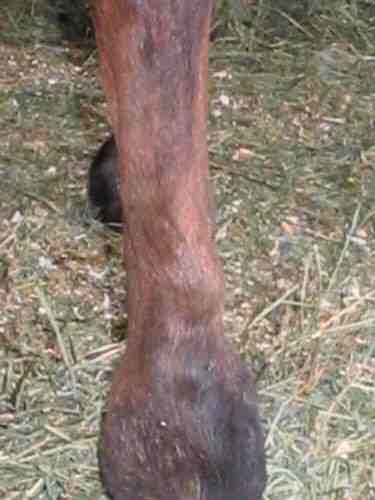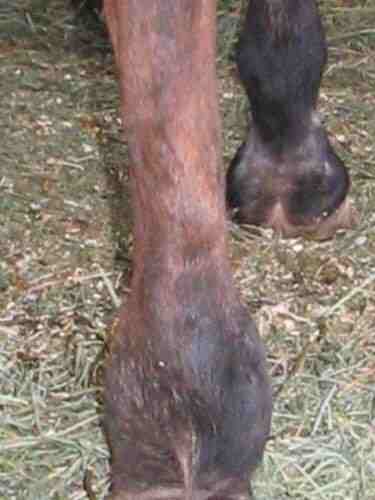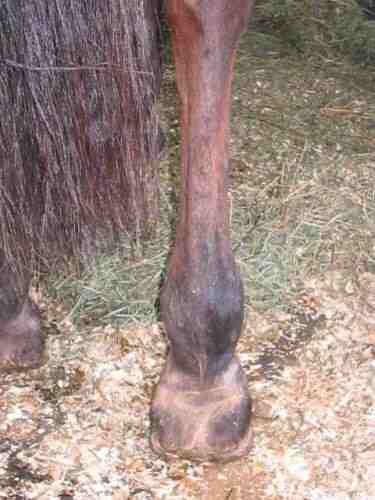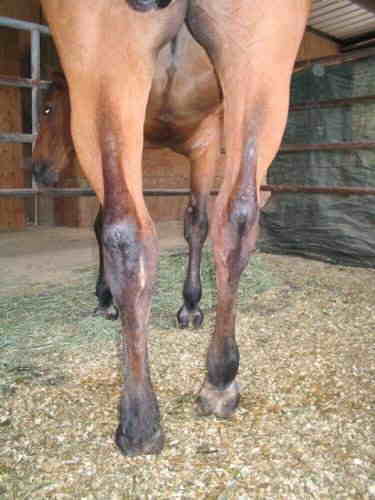Site Menu:
| This is an archived Horseadvice.com Discussion. The parent article and menus are available on the navigation menu below: |
| HorseAdvice.com » Diseases of Horses » Lameness » Muscle & Tendon Diseases » Tendon Laxity and Contracture » |
| Discussion on Bulging Superficial Flexor | |
| Author | Message |
| Member: Hwood |
Posted on Tuesday, Jun 7, 2005 - 11:16 pm: Dear Dr. O.,There is a mare at my barn which has been suffering from arthritis in her lumbar vertebrae, and she is also showing some lameness in her right hind leg. For the past few years she has been pastured on a steep hillside which becomes slick in the winter rains here in California. She tends to move somewhat stiffly anyway because she has terrible arthritis in her knees, but I noticed a hind-end lameness this winter, and pulled her off the hill. Since the end of March, she has been stalled in a 12x24' stall with turnout in level paddocks. Her owner rides her seldom and gently. I had her on one bute a day, and her owner gives her a glucosamine supplement and has a Natural Trim farrier. She often rests her right hind foot on the toe, and yesterday while I was cleaning her stall, I noticed that the tendon above her fetlock was bulging, not outward, but side to side in an "S" shape. Her right hip is definitely higher than her left, and she tries not to take much weight on her right leg when standing, but she walks with a steady beat; no hopping. What does the "S" shape-at-rest tendon signify? When she rests her left hind, the left superficial flexor remains straight. Thank you. |
| Moderator: DrO |
Posted on Wednesday, Jun 8, 2005 - 9:48 am: Hello Holly,Would it be possible to take a picture and also a picture of the normal side when it is in the same resting position? The location of the S and the appearance of the surrounding tissues may also have important information. When a horse rests on his toe the flexors are totally disengaged but what happens to the slack? Usually the flexor muscles readily absorb any slack through shortening. I can think of several reasons why this might occur:
All of these conditions could have a fairly normal walk especially if chronic and a complete exam of the leg should be enough to rule in or out these conditions. DrO |
| Member: Hwood |
Posted on Wednesday, Jun 8, 2005 - 11:36 am: Thanks, Dr. O.I will try to get pics this morning. |
| Member: Hwood |
Posted on Wednesday, Jun 8, 2005 - 1:39 pm: Dr. O.,I will e-mail the pics to you as I can't seem to get them to upload . . . too big, and I don't have a program for reducing them . . . I read the posts about changing the size of photos, but it's all Greek to me (sorry, Christos) . . . |
| Member: Christos |
Posted on Wednesday, Jun 8, 2005 - 4:32 pm: Working with photos is too Greek even for Greeks, Holly.I'd be very interested in these pictures if DrO can upload them for us. |
| Member: Paul303 |
Posted on Thursday, Jun 9, 2005 - 12:59 am: Good one, Christos! More than makes up for the fact that you possess the elusive ability to "spring lightly upon your horse's bare back"!Holly and Dr.O: I'd love to see those pictures myself. |
| Moderator: DrO |
Posted on Thursday, Jun 9, 2005 - 9:25 am: Here are the photos:   Great shots with wonderful lighting. In the weight bearing photo I think the tendon looks thickened up and the margins a bit irregular particularly around the areas that bulge in the nonweight bearing photos. Holly could we get a similar photo from behind that shows both back legs while weight bearing? Also I would like to see a shot of both legs from the side that includes the hocks. I did reduce these so they all fit in one posting but I think if you save these as jpg and try loading them one post at a time you may get them all up, if not send them to me and I will repost them. DrO |
| Member: Hwood |
Posted on Thursday, Jun 9, 2005 - 11:20 am: Thank you. I will take my camera to the barn, again, today. I did try to post the photos (jpeg.)individually, after I got the message that one or more of the images was/were too big to upload, but I got the same message when I tried to post them singly. I am sorry to have to work to resize them, but it will probably work better if I send them to you in an e-mail.Thanks, again. |
| Moderator: DrO |
Posted on Friday, Jun 10, 2005 - 11:37 am: Got'em I will see if I can get them posted by tomorrow.DrO |
| Moderator: DrO |
Posted on Sunday, Jun 12, 2005 - 7:02 pm: Sorry for the delay guys here are the new shots: 
|
| Moderator: DrO |
Posted on Sunday, Jun 12, 2005 - 7:04 pm:  
|
| Moderator: DrO |
Posted on Sunday, Jun 12, 2005 - 7:18 pm: Looking at them all Holly I think something impedes the smooth movement of the flexor tendon on extreme flexion. 2 possibilities occur to me:
Of course the real questions is what effect on soundness does this cause. The lack of soft tissue swelling suggest these are not causing anything but a mechanical problem. If the horse is lame on this leg, I would do a low volar 4 point block and if I saw no improvement do a high volar 4 point block, if the lameness improves I think you have your suspect. The again I may feel entirely different about the whole deal if I could see the horse move and could palpate these structures: perhaps the bulges are not the tendon at all but the structures around the tendon and it runs relatively straight through it? I swear I think I see a dimple where there ought to be tendon in that first photo however. DrO |
| Member: Hwood |
Posted on Sunday, Jun 12, 2005 - 8:59 pm: Thank you, so much, Dr. O. for doing this on your Sunday. Is there a better way I can take the photos? When I put them in the e-mail, I had a choice of how large to make them. Would it be better for you if I sent the smallest size? When I see the photos the way they are posted on HA, they are blurry to me, but when I look at them the way they are saved on my computer, they are much clearer.Is there a way I can palpate the tendon at rest and under stress to see if it is an adhesion issue or a tendon sheath issue? Thanks, again, so much. |
| Moderator: DrO |
Posted on Monday, Jun 13, 2005 - 6:09 am: It is important when comparing 2 legs that the horse is fairly square. To avoid differential magnification you make sure you are the same distance from the 2 legs or when that is not possible, you stand way back and then use telephoto. There will still be some differential magnification but it will be much less significant.The upper parts of the deformity are well out of the sheath so I don't think that is it. Hmmm you know it could even be an adhesion between the 2 flexors that does not allow them to slide against one another. When the foot flexes I think the DDF travels more than the SDF, if they are adhered the DDF might "buckle" taking the SDF with it. How does it look and feel to you? When the horse is standing square do you see a slightly enlarged tendon that has irregular margins? Does the curvy parts palpate like a tendon? It may take a careful ultrasound to demonstrate it. DrO |
| Member: Hwood |
Posted on Monday, Jun 13, 2005 - 12:38 pm: Getting her to stand square is the hard part, Dr. O. When she is "square," she is on her right toe. Today, I will have some help at the barn, so will see what we can do to line her up and get some pics. Also, I have a 15 second video capability on my camera, and I could send you some short walking, trotting segments by e-mail.Meanwhile, I just bought the final two ranch horses who have complicated lamenss issues (found homes for the other 14) and I'd like to have a good lamenss vet come and do a lameness clinic (with radiographs, etc.) for those two horses as well as for this mare and one other gelding. I am new to the Bay Area of CA. Do any of you HA members have recommendations of a vet or vets who can come to the ranch and do thorough, efficient lameness exams? Please e-mail me privately at: hollysjubilee@hotmail.com Thanks. |
| Moderator: DrO |
Posted on Wednesday, Jun 15, 2005 - 12:57 pm: Holly I would like to see this horse moving. A shot of walking and trotting to the left, a shot of walking and trotting to the right, and a shot of walking and trotting away from the camera should do it. It is unlikely I would be able to diagnose the cause of a weight bearing lameness but if there are any mechanical problems, perhaps we could pick up those.DrO |
| Member: Fpony |
Posted on Wednesday, Jun 15, 2005 - 2:23 pm: Dr. O, Can you post the videos? I'd love to see, too.Kim |
| Member: Hwood |
Posted on Wednesday, Jun 15, 2005 - 3:18 pm: I will do my best. It might take me awhile to get the proper shots and perspectives. Thank you for taking an interest. |
| Member: Hwood |
Posted on Wednesday, Jun 22, 2005 - 7:26 pm: Hi, all,Just to let you know that I tried to film the mare while walking and trotting . . . I'm not very adept at focusing and holding down the "film" button at the same time while trying to catch a moving object on film. I gave up after the third try. I asked the owner if he had a video camera, and he does, but he has been sick so hasn't brought it out to the ranch. I've scheduled a lameness clinic here on July 13, at which time, we will have the vet do a work-up on the mare. She has other lameness problems besides the tendon issue in the right hind. If I can get films, I will attempt to send them to you, Dr. O., and I will post the vet's findings and recommendations following the clinic. |
| Moderator: DrO |
Posted on Thursday, Jun 23, 2005 - 6:41 am: Thanks for trying Holly and keep us appraised.DrO |
is The Horseman's Advisor
Helping Thousands of Equestrians, Farriers, and Veterinarians Every Day
All rights reserved, © 1997 -
